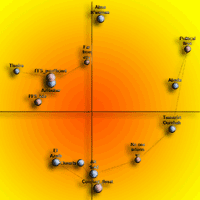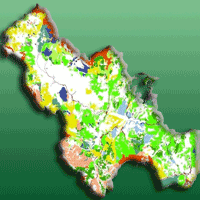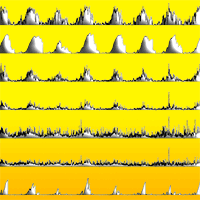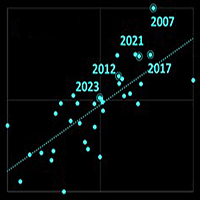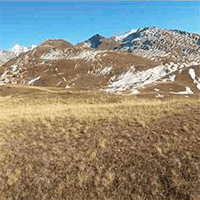The evaluation of forest fuel loading is required by most fire management activities. However, the consideration of shrub biomass for forest planning purposes has been limited by the inability to predict its growth and accumulation. The main objective of this study was to model shrub biomass over time under a tree canopy to be able to include shrub management in fire risk mitigation plans. Data for this purpose was obtained from the 4th and 5th Portuguese National Forest Inventories. Five biologically realistic models were built to describe shrub biomass accumulation in Portuguese forests. The selected model indicates that maximum biomass is affected by stand basal area and the percentage of resprouting shrub species in the stand. Biomass growth rate was clearly affected by the regeneration strategies of shrubs in combination with climatic conditions (mean annual temperature). The model can be used in the accumulation form for initialization purposes or in one of the two alternative difference forms to project observed shrub biomass. The acquired ability to estimate shrub biomass facilitates its inclusion in forest growth models and simulators and will contribute to more accurate estimates of fire behaviour characteristics and stored carbon. This is instrumental to improve decision-making in forest management plans that integrate fire risk, namely to schedule understory fuel treatments.
Keywords
, , , , ,
Citation
Botequim B, Zubizarreta-Gerendiain A, Garcia-Gonzalo J, Silva A, Marques S, Fernandes PM, Pereira JMC, Tomé M (2015). A model of shrub biomass accumulation as a tool to support management of Portuguese forests. iForest 8: 114-125. - doi: 10.3832/ifor0931-008
Academic Editor
Giorgio Matteucci
Paper history
Received: Dec 14, 2012
Accepted: Apr 15, 2014
First online: Jul 27, 2014
Publication Date: Apr 01, 2015
Publication Time: 3.43 months
© SISEF - The Italian Society of Silviculture and Forest Ecology 2015
Open Access
This article is distributed under the terms of the Creative Commons Attribution-Non Commercial 4.0 International (https://creativecommons.org/licenses/by-nc/4.0/), which permits unrestricted use, distribution, and reproduction in any medium, provided you give appropriate credit to the original author(s) and the source, provide a link to the Creative Commons license, and indicate if changes were made.

Breakdown by View Type
(Waiting for server response...)
Article Usage
Total Article Views: 57712
(from publication date up to now)
Breakdown by View Type
HTML Page Views: 47040
Abstract Page Views: 4283
PDF Downloads: 4919
Citation/Reference Downloads: 50
XML Downloads: 1420
Web Metrics
Days since publication: 4183
Overall contacts: 57712
Avg. contacts per week: 96.58
Article Citations
Article citations are based on data periodically collected from the Clarivate Web of Science web site
(last update: Mar 2025)
Total number of cites (since 2015): 37
Average cites per year: 3.36
Publication Metrics
by Dimensions ©
Articles citing this article
List of the papers citing this article based on CrossRef Cited-by.
(1)
Amaro A, Reed D, Tomé M, Themido I (1998)Modeling dominant height growth: eucalyptus plantation in Portugal. Forest Science 44: 37-46.
Online |
Gscholar
(2)
Arnan X, Rodrigo A, Retana J (2007)Post-fire regeneration of Mediterranean plant communities at a regional scales is dependent on vegetation type and dryness. Journal of Vegetation species 18: 11-122.
CrossRef |
Gscholar
(3)
Baeza M, Raventos J, Escarré A, Vallejo VR (2006)Fire risk and vegetation structural dynamics in Mediterranean shrubland. Plant Ecology 187 (2): 189-201.
CrossRef |
Gscholar
(4)
Brown JK (1971)A planar intersect method for sampling fuel volume and surface area. Forest Science 17 (1): 96-102.
Online |
Gscholar
(5)
Bond WJ, Van Wilgen BW (1996)Fire and plants (1st edn). Population and Community Biology Series 14, Chapman and Hall, London, UK, pp. 263.
CrossRef |
Gscholar
(6)
Bonet JA, Pukkala T, Fischer CR, Palahí M, Martinez de Aragón J, Colinas C (2008)Empirical models for predicting the production of wild mushrooms in Scots pine (
Pinus sylvestris L.) forests in the Central Pyrenées. Annals of Forest Science 65 (2): 206-206.
CrossRef |
Gscholar
(7)
Botequim B, Borges P, Carreiras J, Oliveira MM, Borges J (2009)Development of a shrub growth model in understory conditions (preliminary model). Technical Report 7, FORCHANGE, Instituto Superior de Agronomia, Lisboa, Portugal, pp. 12.
Gscholar
(8)
Botequim B, Garcia-Gonzalo J, Marques S, Ricardo A, Borges JG, Oliveira MM, Tomé J, Tomé M (2013)Assessing wildfire risk probability in
Eucalyptus globulus Labill stands in Portugal. iForest 6: 217-227.
CrossRef |
Gscholar
(9)
Broncano MJ, Retana J, Rodrigo A (2005)Predicting the recovery of Pinus halepensis and Quercus ilex forests after a large wildfire in northeastern Spain. Plant Ecology 180: 47-56.
CrossRef |
Gscholar
(10)
Burkhart HE, Tomé M (2012)Modeling forest trees and stands. Springer, Berlin, Germany, pp. 457.
CrossRef |
Gscholar
(11)
Calvo L, Tárrega R, Luis E, Valbuena L, Marcos E (2005)Recovery after experimental cutting and burning in three shrub communities with different dominant species. Plant Ecology 175-185.
CrossRef |
Gscholar
(12)
Canadell J, Zedler PH (1995)Underground structures of woody plants in Mediterranean ecosystems of Australia, California, and Chile. In: “Ecology and Biogeography of Mediterranean Ecosystems in Chile, California and Australia” (Arroyo MTK, Zedler PH, Fox Deds M). Springer-Verlag, New York, USA, pp. 177-210.
CrossRef |
Gscholar
(13)
Canadell JG, Raupach MR (2008)Managing forests for climate change mitigation. Science 320: 1456-1457.
CrossRef |
Gscholar
(14)
Castedo-Dorado F, Gómez-Vásquez I, Fernandes PM, Crecente-Campo F (2012)Shrub fuel characteristics estimated from overstory variables in NW Spain pine stands. Forest Ecology and Management 275: 130-141.
CrossRef |
Gscholar
(15)
Castro H, Freitas H (2009)Above-ground biomass and productivity in the Montado: from herbaceous to shrub dominated communities. Journal of Arid Environments 73 (4-5): 506-511.
CrossRef |
Gscholar
(16)
Cesaraccio C, Spano D, Duce P, Snyder RL (2001)An improved model for determining degree-day values from daily temperature data. International Journal of Biometeorology 45 (4): 161-169.
CrossRef |
Gscholar
(17)
Chmielewski FM, Rötzer T (2001)Response of tree phenology to climate change across Europe. Agricultural and Forest Meteorology 108 (2): 101-112.
CrossRef |
Gscholar
(18)
Chojnacky DC (1992)Estimating volume and biomass for dryland oak species. In: Proceedings of the Conference “Ecology and Management of oaks and Associated Woodlands: Perspectives in the Southwestern United States and Northern Mexico”. Sierra Vista (Arizona, USA) 27-30 April 1992. Rocky Mountain Forest and Range Experiment Station, USDA Forest Service, Fort Collins, CO, USA, pp. 151-161.
Online |
Gscholar
(19)
Cieszewski CJ, Bailey RL (2000)Generalized algebraic difference approach: theory based derivation of dynamic equations with polymorphism and variable asymptotes. Forest Science 46: 116-126.
Gscholar
(20)
Clutter JL, Fortson JC, Pienaar LV, Brister GH, Bailey RL (1983)Timber management: a quantitative approach. John Wiley and Sons, Inc, New York, USA, pp. 333.
Gscholar
(21)
Coll L, González-Olabarria JR, Mola-Yudego B, Pukkala T, Messier C (2011)Predicting understory maximum shrubs cover using altitude and overstory basal area indifferent Mediterranean forests. European Journal of Forest Research 130: 55-65
CrossRef |
Gscholar
(22)
Correia OA, Martins AC, Catarino FM (1992)Comparative phenology and seasonal foliar nitrogen variation in Mediterranean species of Portugal. Ecologia Mediterranea 18: 7-18.
Online |
Gscholar
(23)
DGF (2001)Inventário Florestal Nacional: Portugal Continental (3ª Revisão) [Forest National Inventory: Portugal (3rd revision)]. Direcção Geral das Florestas, Lisboa, Portugal, pp. 233. [in Portuguese]
Gscholar
(24)
DGRF (2006)Resultados do Inventário Florestal Nacional 2005/2006 (5ª Revisão) [Results from the National Forest Inventory 2005/2006 (5th Revision)]. Direcção Geral dos Recursos Florestais, Lisboa, Portugal, pp. 70. [in Portuguese]
Gscholar
(25)
Fernandes P, Rego FC (1998)Equations for estimating fuel load in shrub communities dominated by
Chamaespartium tridentatum and
Erica umbellata. In: Proceedings of the “3rd International Conference on Forest Fire Research & 14th Fire and Forest Meteorology Conference” (Viegas DX ed). Luso (Portugal) 16-20 Nov 1998. ADAI, University of Coimbra, Coimbra, Portugal, pp. 2553-2564.
Gscholar
(26)
Fernandes PA, Loureiro CA, Botelho HS (2004)Fire behaviour and severity in a maritime pine stand under differing fuel conditions. Annals of Forest Science 61 (6): 537-544.
CrossRef |
Gscholar
(27)
Fernandes PM, Rigolot E (2007)The fire ecology and management of maritime pine (
Pinus pinaster Ait.). Forest Ecology and Management 241 (1-3): 1-13.
CrossRef |
Gscholar
(28)
Fernandes PM (2009a)Combining forest structure data and fuel modelling to classify fire hazard in Portugal. Annals of Forest Science 66 (4): 415-415.
CrossRef |
Gscholar
(29)
Fernandes PM (2009b)Examining fuel treatment longevity through experimental and simulated surface fire behaviour: a maritime pine case study. Canadian Journal of Forest Research 39 (12): 2529-2535.
CrossRef |
Gscholar
(30)
Fernández Alés R, Martín A, Ortega F, Alés EE (1992)Recent changes in landscape structure and function in a Mediterranean region of Spain (1950-1984). Landscape Ecology 7: 3-18.
CrossRef |
Gscholar
(31)
Ferreira L, Constantino M, Borges J, Garcia-Gonzalo J (2012)A stochastic dynamic programming approach to optimize short-rotation coppice systems management scheduling: an application to eucalypt plantations under wildfire risk in Portugal. Forest Science 58 (4): 353-365.
CrossRef |
Gscholar
(32)
Ferreira L, Constantino M, Borges JG (2014)A stochastic approach to optimize Maritime pine (
Pinus pinaster Ait.) stand management scheduling under fire risk: an application in Portugal. Annals of Operations Research 219 (1): 359-377.
CrossRef |
Gscholar
(33)
Garcia-Gonzalo J, Marques S, Borges JG, Botequim B, Oliveira MM, Tomé J, Tomé M (2011)A three-step approach to post-fire mortality modelling in Maritime pine (
Pinus pinaster Ait) stands for enhanced forest planning in Portugal. Forestry 84 (2): 197-206.1
CrossRef |
Gscholar
(34)
Garcia-Gonzalo J, Zubizarreta-Gerendiain A, Ricardo A, Marques S, Botequim B, Borges J. G, Oliveira MM, Tomé M, Pereira JMC (2012)Modelling wildfire risk in pure and mixed forest stands in Portugal. Allgemeine Forst und Jagdzeitung (AFJZ) - German Journal of Forest Research 183 (11/12): 238-248.
Gscholar
(35)
Garcia-Gonzalo J, Pukkala T, Borges J (2014)Integrating fire risk in stand management scheduling. An application to Maritime pine stands in Portugal. Annals of Operations Research 219 (1): 379-395.
CrossRef |
Gscholar
(36)
González JR, Palahi M, Pukkala T (2006)A fire probability model for forest stands in Catalonia (north-east Spain). Annals of Forest Science 63: 1-8.
CrossRef |
Gscholar
(37)
Gould JS, McCaw WL, Cheney NP (2011)Quantifying fine fuel dynamics and structure in dry eucalypt forest (
Eucalyptus marginata) in Western Australia for fire management. Forest Ecology and Management 262 (3): 531-546.
CrossRef |
Gscholar
(38)
Hosmer DW, Lemeshow S (2000)Applied logistic regression (2nd edn). Series “Probability and Mathematical Statistics”, no. 452, Wiley, New York, USA, pp. 307.
Gscholar
(39)
Hurteau MD, North M (2010)Carbon recovery rates following different wildfire risk mitigation treatments. Forest Ecology and Management 260: 930-937.
CrossRef |
Gscholar
(40)
Joffre R, Rambal S (2002)Mediterranean Ecosystems. In: “Encyclopedia of Life Science” (edn M.P. Ltd). Nature Publishing Group, London, UK, pp. 1-7.
Gscholar
(41)
Keeley JE, Zedler PH (1978)Reproduction of Chaparral shrubs after fire: a comparison of sprouting and seeding strategies. American Midland Naturalist 99: 142-161.
CrossRef |
Gscholar
(42)
Keeley JE (1986)Resilience of Mediterranean shrub communities to fire. In: “Resilience in Mediterranean-type ecosystems” (Dell B, Hopkins AJM, Lamont Beds B). Dr W Junk Publishers, Dordrecht, The Netherlands, pp. 95-112.
Gscholar
(43)
Kozlowski TT, Kramer PJ, Pallardy SG (1991)The physiological ecology of woody plants. Academic Press Inc, San Diego, CA, USA, pp. 30.
Gscholar
(44)
Kummerow J, Montenegro G, Krause D (1981)Biomass, phenology and growth. In: “Resource Use by Chaparral and Matorral” (Miller PC ed). Ecological studies, vol. 39, Springer-Verlag, New York, USA, pp. 69-96.
CrossRef |
Gscholar
(45)
Lloret F, Pausas J G, Vila M (2003)Responses of Mediterranean plant species to different fire frequencies in Garraf Natural Park (Catalonia, Spain): field observations and modelling predictions. Plant Ecology 167: 223-235.
CrossRef |
Gscholar
(46)
Maak K, von Storch H (1997)Statistical downscaling of monthly mean air temperature to the beginning of flowering of
Galanthus nivalis L. in northern Germany. International Journal of Biometeorology 41 (1): 5-12.
CrossRef |
Gscholar
(47)
Malmsheimer RW, Heffernan P, Brink S, Crandall D, Deneke F, Galik C, Gee E, Helms JA, McClure N, Mortimer M, Ruddell S, Smith M, Stewart J (2008)Forest management solutions for mitigating climate change in the United States. Journal of Forestry 106 (3): 115-171.
Gscholar
(48)
Marques S, Garcia-Gonzalo J, Botequim B, Ricardo A, Borges JG, Tomé M, Oliveira MM (2012)Assessing wildfire risk probability in
Pinus pinaster Ait. stands in Portugal. Forest Systems 21 (1): 111-120.
CrossRef |
Gscholar
(49)
McCaw L, Neal J, Smith R (2002)Stand characteristics and fuel accumulation in a sequence of even-aged karri (
Eucalyptus diversicolor) stands in south-west Western Australia. Forest Ecology and Management 158: 263-271.
CrossRef |
Gscholar
(50)
Mercer DE, Haigth RG, Prestemon JP (2008)Analyzing trade-offs between fuels management, suppression, and damages from wildfire. In: “The Economics of Forest Disturbances: Management, Suppression, and Damages from Wildfire” (Holmes TP, Prestemon JP, Abt KL eds). Series “Forestry Sciences”, vol. 79, Springer, The Netherlands, pp. 247-272.
CrossRef |
Gscholar
(51)
Midgley JJ (1996)Why the world’s vegetation is not totally dominated by resprouting plants; because reprouters are shorter than reseeders. Ecography 19: 92-95.
CrossRef |
Gscholar
(52)
Myers RH (1990)Classical and modern regression with applications. PWS-Kent Publishing, Boston, USA, pp. 488.
Gscholar
(53)
Navar J, Nájera J, Jurado E (2001)Preliminary estimates of biomass growth in the Tamaulipan thornscrub in north-eastern Mexico. Journal of Arid Environments 47: 281-290.
CrossRef |
Gscholar
(54)
Olson JS (1963)Energy storage and the balance of producers and decomposers in ecological systems. Ecology 44: 322-331.
CrossRef |
Gscholar
(55)
Palahí M, Tomé M, Pukkala T, Trasobares A (2004)Site index model for
Pinus sylvestris in north-east Spain. Forest Ecology and Management 187: 34-47.
CrossRef |
Gscholar
(56)
Palahí M, Pukkala T, Bonet JA, Colinas C, Fischer CR, Martínez de Aragón JR (2009)Effect of the inclusion of mushroom values on the optimal management of even-aged Pine stands of Catalonia. Forest Science 55 (60): 503-511(9).
Online |
Gscholar
(57)
Parresol BR (1999)Assessing tree and stand biomass: a review with examples and critical comparisons. Forest Science 45 (4): 573-593.
Online |
Gscholar
(58)
Pate JS, Froend RH, Bowen BJ, Hansen A, Kuo J (1990)Seedling growth and storage characteristics of seeder and resprouter species of Mediterranean-Type ecosystems of SW Australia. Annals of Botany 65: 585-601.
Online |
Gscholar
(59)
Pausas JG (2001)Resprouting
vs. seeding - a Mediterranean perspective. Oikos 94: 193-194.
CrossRef |
Gscholar
(60)
Pausas JG (2004)Changes in fire and climate in the eastern Iberian Peninsula (Mediterranean basin). Climatic Change 63: 337-350.
CrossRef |
Gscholar
(61)
Pausas JG, Bradstock RA, Keith DA, Keeley JE (2004)The GCTE Network. Plant functional traits in relation to fire in crown-fire ecosystems. Ecology 85: 1085-1100.
CrossRef |
Gscholar
(62)
Pausas JG, Keeley JE, Verdú M (2006)Inferring differential evolutionary processes of plant persistence traits in Northern Hemisphere Mediterranean fire-prone ecosystems. Journal of Ecology 94: 31-39.
CrossRef |
Gscholar
(63)
Pereira JMC, Santos TN (2003)Fire risk and burned area mapping in Portugal. Direcção Geral das Florestas, Lisboa, Portugal. [in Portuguese]
Gscholar
(64)
Plucinski MP (2003)The investigation of factors governing ignition and development of fires in heathland vegetation. PhD thesis, University of New South Wales - Australian Defence Force Academy, School of Mathematics and Statistics, Sidney, Australia, pp. 366.
Gscholar
(65)
Rambal S, Hoff C (2001)Mediterranean ecosystems and fire: the threats of global change. In: “Large Forest Fires” (Moreno JM ed). Backbuys Publishers, Leiden, The Netherlands, pp. 187-213.
Gscholar
(66)
Richards FJ (1959)A flexible growth function for empirical use. Journal of Experimental Botany 10 (2): 290-301.
CrossRef |
Gscholar
(67)
Rosa IM, Pereira JM, Tarantola S (2011)Atmospheric emissions from vegetation fires in Portugal (1990-2008): estimates, uncertainty analysis, and sensitivity analysis. Atmospheric Chemistry and Physics 11: 2625-2640.
CrossRef |
Gscholar
(68)
SAS Institute Inc (2000)SAS/STAT user’s guide (v. 8 edn). SAS Institute Inc, Cary, NC, USA.
Gscholar
(69)
Schmidt KM, Menakis JP, Hardy CC, Hann WJ, Bunnell DL (2002)Development of coarse-scale spatial data for wildland fire and fuel management. Gen. Tech. Rep. RMRS-GTR-87, Rocky Mountain Research Station, USDA Forest Service, Fort Collins, CO, USA, pp. 41.
Gscholar
(70)
Schumacher FX (1939)A new growth curve and its application to timber-yield studies. Journal of Forestry 37: 819-820.
Gscholar
(71)
Tomé M, Oliveira T, Soares P (2006a)O modelo Globulus 3.0. [The Globulus model 3.0.] Publicações GIMREF-RC2/2006, Universidade Técnica de Lisboa. Instituto Superior de Agronomia. Centro de Estudos Florestais. Lisboa, Portugal, pp. 23.
Gscholar
(72)
Tomé J, Tomé M, Barreiro S, Paulo JA (2006b)Age-independent difference equations for modelling tree and growth. Canadian Journal of Forest Research 36: 1621-1630.
CrossRef |
Gscholar
(73)
Trabaud L, Grosman J, Walter T (1985)Recovery of burnt
Pinus halepensis Mill. Forest. I. Understorey and litter phytomass development after wildfire. Forest Ecology and Management 12 (3-4): 269-277.
CrossRef |
Gscholar
(74)
Vanclay JK, Skovsgaard JP (1997)Evaluating forest growth models. Ecological Modelling 98:1-12.
CrossRef |
Gscholar
(75)
Vega JA, Fernandes P, Cuinas P, Fonturbel M, Perez J, Loureiro C (2006)Fire spread analysis of early summer field experiments in shrubland fuel types of northwestern Iberia. Forest Ecology and Management 234: S102.
Gscholar
(76)
Zedler PH (1995)Fire frequency in southern California shrublands: biological effects and management options. In: “Brushfires in California wildlands: ecology and resource management” (Keeley JE, Scott T). International Association of Wildland Fire, Fairfield, Washington, DC, USA, pp. 101-112.
Gscholar


